Kilmainham Gaol (Jail), Dublin, Ireland
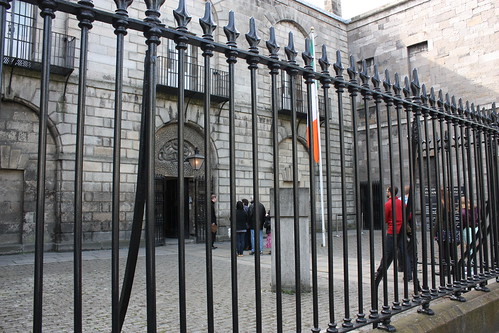
The entrance to Kilmainham Gaol, Dublin.
–
I was talking recently with some friends, and they were telling me about a new phenomenon in the processing of coffee beans. The fad involved coffee cherries that are passed through the digestive track of a civet cat (mammals native to the islands of Java and Sumatra). The cats can’t process the beans themselves, so those are excreted whole, and then gathered by coffee connoisseurs, who claim that the fermentation process that occurred inside the animals digestive track makes the beans taste better. The result, they maintain, is a superior cup of coffee.
In short, people are using coffee beans that cats have pooped out.
If you are anything like me, hearing this news on an early and crisp January morning is more than enough to cause you to bid adieu to mankind as a whole, return your bed, and weep for the future of our species. Because, and I can’t believe I really need to say this, WE SHOULD NOT BE INGESTING THINGS WE FIND IN CAT POOP.
It also makes me wonder if maybe we’ve all gone a little bit soft. If, for many of us, life has gotten just a little too good, a little too easy, that we can devote our time to such excesses.
For those of us living in a world of pooped-out coffee, My Super Sweet 16, and vajazzling (if you are at work, do yourself a huge favor and DO NOT CLICK ON THAT LINK), I feel like reality checks are necessary every now and then.
My most recent one came courtesy of Kilmainham Jail (or Gaol, as we often saw it spelled), in Dublin.
Going to Kilmainham was Rand’s idea, and since he had such limited free time in Ireland, I jumped at the suggestion. Besides, he so rarely leads me astray. When I listen to him, I end up eating cake for dinner and buying a new pair of shoes. He’s really great like that.
Kilmainham fit perfectly into the narrative of Ireland we’d been composing throughout our trip. I’ve mentioned the Easter Rising at length, and the jail had a rather important role in that, too, which I’ll get to later. But Kilmainham existed long before the Easter Rising of 1916.
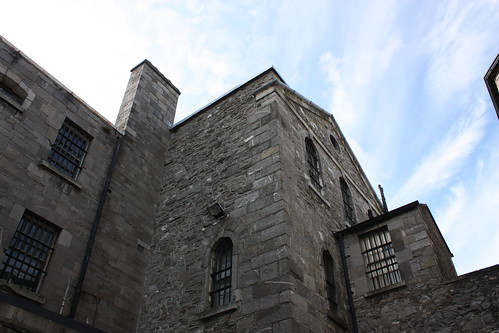
We happened to go on a sunny day.
–
When Kilmainham was first built, back in the late 1700s, it was a cutting-edge sort of facility.

Note: in the 18th century, “cutting edge” did not mean “nice”.
–
Prior to then, jails were much different. Everyone was held in one big, dank room – men, women, and even children. Yeah, that’s right – children. If parents were imprisoned and their kids had nowhere to go, they’d be incarcerated as well.
Conditions were terrible. Torture, corruption, vermin, illness, prostitution, gambling, drinking, and disease were rampant.
So, basically, a lot like Vegas. Except with slightly more torture and a lot more children. And less neon.
Food wasn’t necessarily a given, and in order to be fed, or receive blankets, or any measure of human treatment, you had to bribe the guards. (Wow. The Vegas analogy is still holding up.)
Good heavens.
In the late 1700s, a wealthy gentleman by the name of John Howard was appointed High Sheriff of Bedfordshire. Supervision of the local jail fell to him, and Howard was shocked by what he had encountered therein. People were living in absolute squalor, and many succumbed to “prison fever” – a nasty form of typhus that spread quickly through the unsanity conditions of the jails.
Howard set about informing the public of the horrifying conditions prisoners were exposed to. He made many recommendations – that people get their own cells and be provided with food, clean water, and sanitary conditions; that staff be moral and upstanding citizens -role models for the incarcerated. Howard even used his own sizeable fortune to institute such changes.
He was an upstanding guy, and genuinely tried to – and eventually succeeded – in making prison conditions better. So it’s rather heartbreaking to learn that Howard himself would perish from typhus (contracted from one of his many visits to jails), but not before he had suggested some rather notable changes to the prison system.
Kilmainham was a slight improvement on “the noisome dungeons” that had preceded it. It was called “The New Gaol”, to differentiate it from the one it had replaced (an earlier incarnation of the penitentiary had been situated just a few hundred yards away, and was one of the squalor-filled pits that had so horrified Howard). But the new Kilmainham was not the one that Howard would have envisioned. Built 6 years after his death, he likely would have been horrified by it.
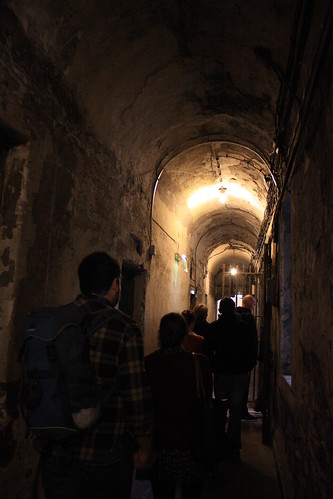
–
It was not a pleasant place.
Prisoners continued to be held in terrible conditions. They spent much of their time in the freezing cold, as the chill air was believed to purify a corrupt spirit. The walls of the newly-built Kilmainham were made of lime, meaning that they retained moisture but not heat. There was open window in each of the cells (with no glass pane) that would let a freezing wind blow through.

It was too high to look out of, too small to provide much light. So its only function, really, was to make the cells frigid and miserable.
–

Even in the mid-afternoon on a bright day, you can see how dark it was.
–
Each prisoner was given a single candle for light and warmth, which was supposed to have lasted them for two weeks.
This part of the prison – now referred to as the west wing, and well over 200 years old – is still standing. Our tour took us through it, and even on the sunny, not-terribly-cold day that we were there, we were all shivering.
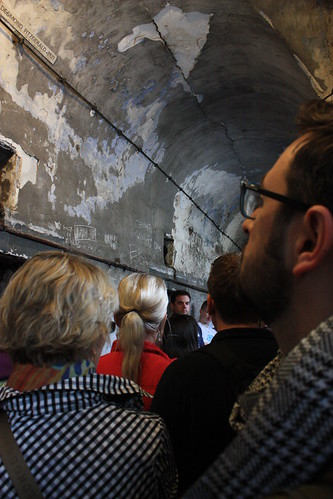
Even with a large group of people, clustered together, we were cold.
–
And keep in mind, today the windows have panes and there’s track lighting along the ceiling. One can only imagine how cold and dark it would have been back then.
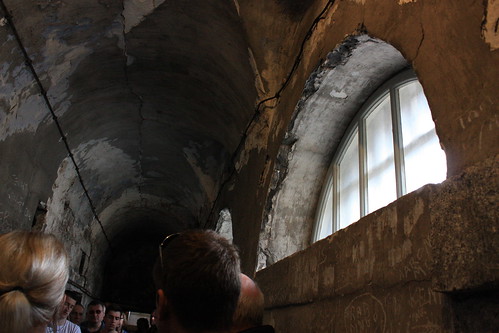
–

–
In the late 1700s and early 1800s, there was no such thing as probation or community service (or starlets using the excuse that they were severely depressed or dehydrated when they drove their car into the side of a Wendy’s). Minor infractions would land you in prison, regardless of your age (stealing a loaf of old bread would land you in jail for a month. Digging in the trash outside a bakery or shop could get you a week’s incarceration). The youngest person believed to have been held at Kilmainham was 7 years old.
The jail soon became overcrowded. Adding to the issue was the famine and starvation that plagued Ireland during the time. Many people, upon hearing that you might be able to get a meager ration of food inside prison, would commit minor infractions in order to get themselves arrested (the logic was that inside Kilmainham, you had a chance at survival. Outside of the jail, you didn’t).
Cells that had been designed for one person now held as many as five or six (the smell, one can safely assume, must have been intense. This was before the days of toothbrushing. Or deodorant. Or even moist towelettes).
It was hard for me to capture the dimensions of the cells, but they’re about the size of a generous home closet – about 60 square feet or so.

It’s hard to get a sense of scale, but the cells were about 6 feet across and probably 8 or ten feet deep. The gentleman at right is on the taller side – around 6’2″, I’d guess. Notice how close the doors are to one another.
–
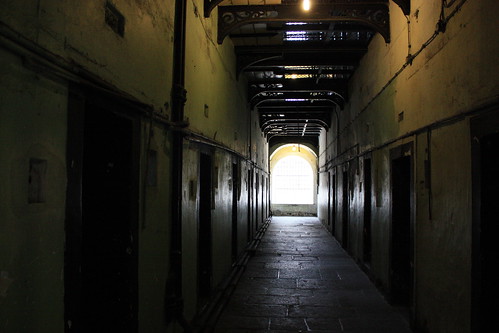
This corridor led to the Stonebreaker’s Yard, where the executions took place.
–
And, as was fairly common in the 18th century, the ladies had it worse than the men. Male prisoners often were less cramped, and were given beds to sleep on. Women had to resort to sleeping on piles of hay. And once the cells became too crowded, they had to sleep on piles of hay in the hallways.
Imagine, being in prison and not even having a cell to share with five other people.
After a few decades, it became apparent that Kilmainham’s tactics had failed. Freezing prisoners and cramping them together was evidently not the path to social rehabilitation. (If it was, then everyone lining up outside for Black Friday deals would be a friggin saint. And judging by how many people accosted each other outside a Victoria’s Secret last year in a quest for discounted frilly panties, THEY ARE NOT.)
In the mid 1800s, the east wing of the prison was built, this time incorporating Howard’s reforms and tenants, none of which involved limestone (thankfully). As our tour took us to this newer part of the jail, I could actually see everyone relax a little bit. Compared to the old wing, it was like a Hilton.
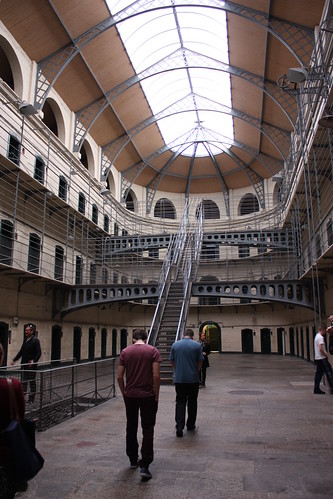
Notice that it was warm enough for people to finally remove their jackets.
–
Okay, so it still wasn’t exactly roomy.
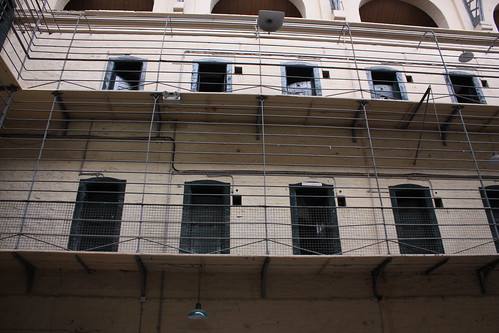
So I guess it was more like a Hilton in Manhattan or something.
–
The new design added another 96 cells to the prison – and this time, each one really did house only one inmate. Conditions weren’t ideal, but they were significantly brighter and more spacious.

My wee, 5’8″ husband illustrates the size of the cell. Don’t let the high ceiling fool you; it’s barely big enough for a twin bed.
–
In addition to being a clear aesthetic improvement, the new, panopticon design was practical, too – guards could now clearly see all of the cells, and could move easily between the floors and sides of the prison using catwalks and central staircases.
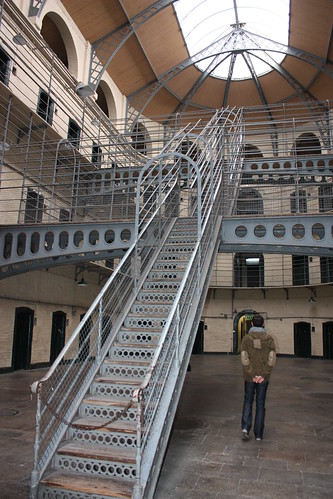
–

Our lovely and knowledgeable tour guide discusses the vastly improved east wing.
–
There was even warm food delivered up from the kitchen through a manhole in the ground.

–
So what became of the old, freezing west wing? Well, it remained in use. It became the women’s wing of the prison. Oy.
As I noted earlier, Kilmainham played a significant role in Ireland’s quest for independence. Remember the Easter Rising? (If not, I wrote about it extensively here.) It was when several Irish Republican leaders signed a proclamation and declared their independence from Britain. Unfortunately, it hadn’t been a widespread, coordinated effort. It led to several weeks of fighting in the streets, and resulted in several hundred dead civilians. Many of the Irish Nationalists who took part in the Rising were arrested and sent to Kilmainham; the leaders were executed.
At the time of their arrest, those who had led the uprising were not held in high regard by many of their countrymen. Talks for Irish homerule had been going well, and people felt that the Rising had jeopardized all of that. According to our guide, many of those who had been arrested were literally spat upon by their compatriots. But in a year, public sentiment would shift, and much of it was because of the treatment of the Nationalist prisoners once they reached Kilmainham.
These two cells belong to Eamon DeValera (who escaped execution on the grounds that he was actually an American citizen), and Edward Daly (who was executed).
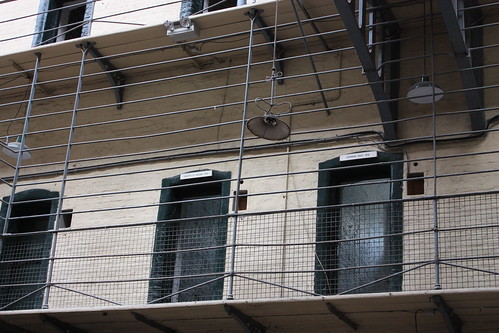
–
Among those killed was Joseph Plunkett. His (and his wife’s) tragic fate at Kilmainham helped turn the tide of public sentiment in favor of the Easter Risers.
Before his arrest, Plunkett became engaged to a woman named Grace Gifford. Gifford’s sister, Muriel, was married to Thomas MacDonagh, a friend of Plunkett’s and a fellow Nationalist. It was through Muriel that Plunkett and Gifford met and fell in love.
Gifford was unaware of the plans for the Easter Rising. Afterwards, Plunkett was arrested, and when Gifford learned that he was to be sentenced to death (along with Thomas Mac Donagh, her sister Muriel’s husband), she went to the prison to find her fiancé and request that they be allowed to marry.
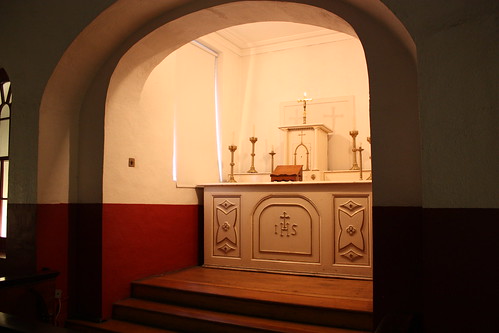
–
The ceremony was performed in this tiny chapel inside Kilmainham. Plunkett was let out of the cell for the ceremony, but had to immediately return to it afterwards. He and Gifford were never even given any time alone together. The next morning, he was executed, one day after his friend Thomas MacDonagh.

Spot where Plunkett, MacDonagh, and the rest of the Easter Risers (with the exception of Connolly) were executed.
–
The Gifford sisters both became widows within 24 hours of each other.
James Connolly was another of the Easter Rising leaders who was executed at Kilmainham. He had been severely injured during the Rising, and in the time since, he wounds had become gangrenous. He was so ill at the time of his execution, that he could not stand for the firing squad. So instead, he was tied to a chair (being too weak to sit upright) and shot.

Spot of James Connolly’s execution.
–
As the news of stories like these spread, public opinion towards the Easter Risers began to change. The leaders were hailed as martyrs. The remaining prisoners were given a heroes’ welcome upon their release. Rather than quash Ireland’s fight for independence, the incidents that transpired at the jail had given it new life.
The jail was decommissioned in 1924, two years after the birth of the Irish free state. Kilmainham fell into disrepair over the next few decades, and there was much talk of demolishing the structure. In response to this, a grassroots organization was born with the goal of rebuilding and preserving the jail. They succeeded in their efforts, and by 1971, the prison had reopened as a museum, and a reminder of the many long struggles in Ireland’s past.
Our tour took us through the old and new wings of the prison, and the courtyards where the executions took place. With each step, all I could think was of the past sufferings of the prisoners there, and how easy many of us have it. How we live in a world full of warm beds and well-lit rooms. How so many of us can curl up next to our love ones at night, watching their chests move gently up and down with each breath. How damn lucky we are to live lives that are full of good health, and comfort, and many, many joys.
And, if we are so inclined, a little cat poop coffee, too.
————–
The Essentials on Kilmainham Gaol
- Verdict: Yes. This was absolutely haunting and fascinating, and was one of my favorite historical sites of our entire trip to Ireland.
– - How to Get There: We took a cab from Temple Bar, and then took public transportation back (the staff was helpful in directing us where to go). The jail’s official website also has some great logistical information about how to get there. Note that if you are going to take a bus in Dublin, waiting at the stop isn’t sufficient enough – you actually have to hail the bus. So get ready to wave like a lunatic.
– - Ideal for: History fans, social reformers, and anyone with a morbid fascination for how bad things used to be (and how easy we have it now).
– - Insider tips: The tour is about 90 minutes long, and though most of it is indoors, the jail is quite chilly. Wear comfortable shoes (you’ll be on your feet), and warm clothes. Give yourself some time beforehand to look at the exhibition of artifacts at the museum and use the facilities before your tour begins (you won’t have a chance once it’s started). Oh, and doing a little reading up on the Easter Rising wouldn’t hurt, either. It puts the entire place is context.
– - Nearby food: There’s a small cafe inside the museum that serves snacks, but Kilmainham is on the edge of town, so there isn’t too much else within walking distance. Fear not, though – it’s a very short bus ride back into town.
– - Good for kids: No. While teenagers will likely be fascinated by the old cells and the tales of the conditions therein, I wouldn’t bring anyone under the age of 12, as the tour is long, chilly, and the dark subject matter might be traumatic. The grounds are not stroller friendly by any means.









Leave a Comment